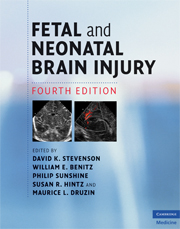Book contents
- Frontmatter
- Contents
- List of contributors
- Foreword
- Preface
- Section 1 Epidemiology, pathophysiology, and pathogenesis of fetal and neonatal brain injury
- Section 2 Pregnancy, labor, and delivery complications causing brain injury
- Section 3 Diagnosis of the infant with brain injury
- Section 4 Specific conditions associated with fetal and neonatal brain injury
- Section 5 Management of the depressed or neurologically dysfunctional neonate
- Section 6 Assessing outcome of the brain-injured infant
- 45 Early childhood neurodevelopmental outcome of preterm infants
- 46 Cerebral palsy: advances in definition, classification, management, and outcome
- 47 Long-term impact of neonatal events on speech, language development, and academic achievement
- 48 Neurocognitive outcomes of term infants with perinatal asphyxia
- 49 Appropriateness of intensive care application
- 50 Medicolegal issues in perinatal brain injury
- Index
- Plate section
- References
49 - Appropriateness of intensive care application
from Section 6 - Assessing outcome of the brain-injured infant
Published online by Cambridge University Press: 12 January 2010
- Frontmatter
- Contents
- List of contributors
- Foreword
- Preface
- Section 1 Epidemiology, pathophysiology, and pathogenesis of fetal and neonatal brain injury
- Section 2 Pregnancy, labor, and delivery complications causing brain injury
- Section 3 Diagnosis of the infant with brain injury
- Section 4 Specific conditions associated with fetal and neonatal brain injury
- Section 5 Management of the depressed or neurologically dysfunctional neonate
- Section 6 Assessing outcome of the brain-injured infant
- 45 Early childhood neurodevelopmental outcome of preterm infants
- 46 Cerebral palsy: advances in definition, classification, management, and outcome
- 47 Long-term impact of neonatal events on speech, language development, and academic achievement
- 48 Neurocognitive outcomes of term infants with perinatal asphyxia
- 49 Appropriateness of intensive care application
- 50 Medicolegal issues in perinatal brain injury
- Index
- Plate section
- References
Summary
Introduction
Ethical questions in medicine revolve around three core topics: what needs to be decided, on what basis, and by whom. These matters are not unique to the perinatal period, nor to patients with brain injury, but both of those circumstances may have ethical implications in the decision-making process, and in combination they raise questions that are unique. Because these situations touch so many critical aspects of human existence – birth, death, personhood, parenthood, etc. – it is not surprising that ethical matters related to the perinatal period have garnered a disproportionate amount of attention in the public discourses on medical ethics, nor that brain integrity lies at the core of so many of the contentious cases. The philosophical underpinnings of medical ethics have been reviewed exhaustively in many other venues, so this discussion will focus on aspects that are unique to or uniquely framed by brain injury or dysfunction in the perinatal period.
What is to be decided?
In the lay literature, ethical dilemmas are often framed as “life-or-death” decisions, with the implication that death or survival are options to be freely selected by patients, family members, or care providers, and that the ultimate outcome is within their control. In reality, that is rarely the case. In the case of a patient whose vital signs are rapidly failing despite full application of intensive care measures, this fact is obvious and there is no (or at most a very short-lived) ethical problem.
- Type
- Chapter
- Information
- Fetal and Neonatal Brain Injury , pp. 585 - 597Publisher: Cambridge University PressPrint publication year: 2009



